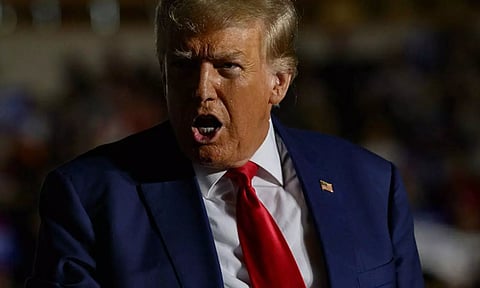

• NOURIEL ROUBINI
UNITED STATES: We have entered a period of intensifying geopolitical rivalries and conflicts. Russia’s war on Ukraine is now in its third year; the Israel-Hamas conflict could still become a regional war; and the deepening cold war between the United States and China may yet turn hot over Taiwan sometime this decade.
If Donald Trump wins the US presidential election in November, the world will be even further destabilised. And yet, these risks have had only a limited effect on economies and markets so far. Might that soon change?
While the Russia-Ukraine war remains as brutal as ever, its global effects are likely to be more modest. The risks of direct NATO involvement or the use of tactical nuclear weapons by Russia are lower today than they were at earlier points in the war. Equally, while the war initially produced a spike in energy, food, fertilizer, and industrial-metal prices, even Europe – the most heavily affected region – has absorbed the shock with only a modest growth slowdown (or a stall in some cases), not the severe recession that many analysts feared.
Russian hydrocarbons have been replaced with increased imports from the US and Middle Eastern countries. The impact on food prices has been reduced since Ukraine managed to reopen a Black Sea corridor for its grain exports.
The Israel-Hamas war has also had only a limited regional and global economic impact so far. True, Israel’s GDP contracted sharply in the fourth quarter of 2023 and will likely remain weak as long as the conflict continues. The economic damage to Gaza, obviously, is even more severe; and Egypt’s revenues from the Suez Canal – a major source of foreign-currency receipts – have fallen, owing to the Yemeni Houthis’ attacks on freight shipping through the Red Sea. Nonetheless, if the conflict remains contained along its current lines, the global economic and market impact will remain limited, too.
After all, it would take a major regional escalation – such as an outright war between Israel and Hezbollah in Lebanon, or signs that Israel (and possibly the US) is on the path to war with Iran – to raise expectations of a more severe global fallout. A full-scale war between Israel and Iran would drastically reduce energy production and exports from the Gulf, causing an energy-price spike akin to the global stagflationary shocks that followed the 1973 Yom Kippur War and the 1979 Iranian Revolution. Fortunately, the probability of a sharp regional escalation remains low for the time being.
While the cold war – or strategic competition – between America and China is likely to continue worsening over time, relations may not deteriorate much this year. US President Joe Biden and his Chinese counterpart, Xi Jinping, agreed to a tactical thaw late last year, and China’s reaction to an undesirable outcome in Taiwan’s presidential election has been relatively restrained. Though the Taiwan issue could come to a boil later this decade, that is not likely to happen this year or next. China’s economic weaknesses and fragilities may lead it to be less confrontational with the US and the West.
At the same time, the West’s derisking, reshoring, friend-shoring, and restriction of trade in goods, services, capital, and technologies will not intensify much over the short term. As long as the strategic competition remains managed, the global economic impact will be modest. The biggest geopolitical risk to growth and markets is the US election. But, here, it is important to recognise that Trump and Biden share some foreign-policy priorities. Democrats and Republicans alike are hawkish on China, and will remain so. Biden and Trump have both been strong supporters of Israel, but they also recognise that the desired normalisation of relations between Israel and Saudi Arabia may require some recognition of an eventual two-state solution.
The biggest difference between Trump and Biden is on the issues of NATO, Europe, and the Russia-Ukraine conflict. Some worry that Trump would abandon Ukraine and let Russia win the war. But since he is likely to remain hawkish on China, he may worry about the signal it would send (regarding Taiwan) to let Russia take over Ukraine. Moreover, what Trump really wants is for European NATO members to spend more on defense. If they do that, he may recognise the alliance’s value as it pivots to Asia to deter China.
The biggest way a second Trump administration would affect markets is through its economic policies. There is no doubt that US protectionist policies would become more severe. Trump has already said he would impose a 10% tariff on all imports coming to the US (the average tariff rate is currently about 2%), and presumably even higher tariffs on imports from China. This would spark new trade wars, not only with strategic rivals like China, but also with America’s allies in Europe and Asia, such as Japan and South Korea.
A global trade war would reduce growth and increase inflation, making it the largest geopolitical risk that markets should consider in the months ahead. In this scenario, deglobalisation, decoupling, fragmentation, protectionism, the balkanisation of global supply chains, and de-dollarisation would become even greater risks to economic growth and financial markets.
Additional Trump-related stagflationary risks include his denialist attitude toward climate change and the likelihood that he would try to replace US Federal Reserve Chair Jerome Powell with a more dovish, pliant figure. Finally, Trump’s fiscal policies would increase deficits that are already too high. Tax cuts that are poised to expire would be extended, as would higher spending on defense and entitlements. The risk of bond vigilantes eventually shocking bond markets with much higher yields would increase. With private and public debts high and rising, that would introduce the specter of a financial crisis.
As the saying goes, “It’s the economy, stupid.” Trump’s proposed economic-policy agenda is now the greatest threat to economies and markets around the world.